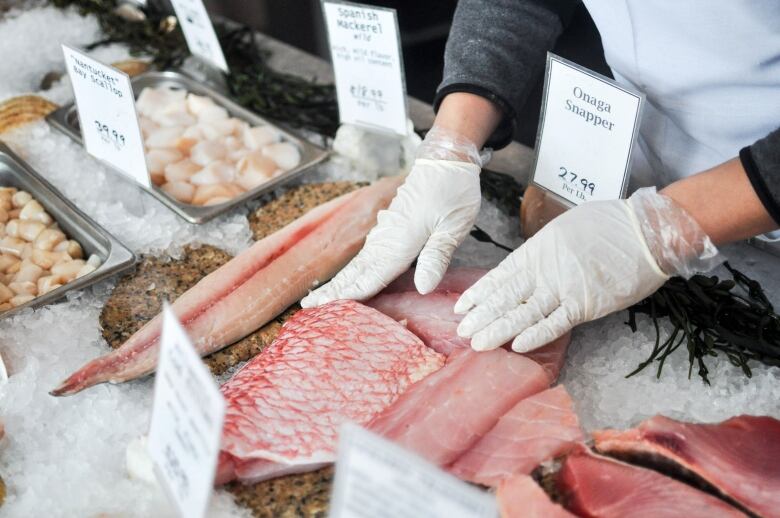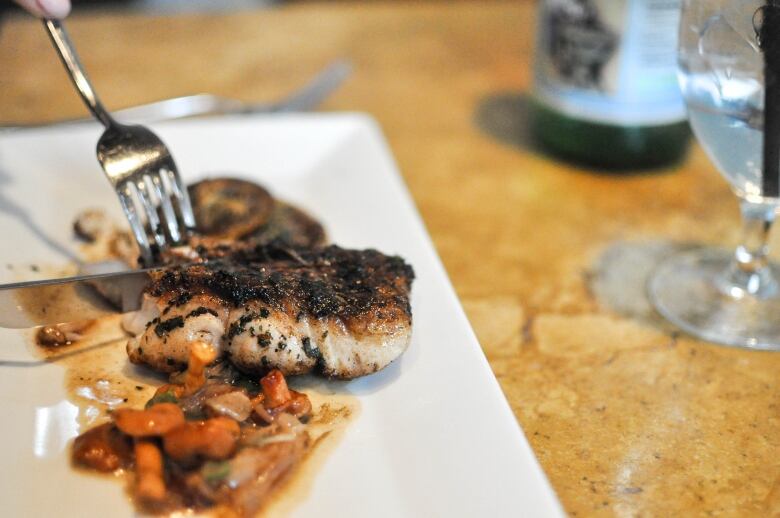Widespread mislabelling of seafood reported in cities across Canada
Oceana Canada calls on authorities to implement full boat-to-plate traceability to combat 'seafood fraud'

An "alarming"rateof seafood in Canadian restaurants and stores is mislabelled, according to a new report by an ocean advocacy group.
Oceana Canada, a Toronto-based conservation organization,saidit found there was mislabelling with 44 per cent of the seafood samples it tested this year and last in five Canadian cities and in 75 per cent ofcases, cheaper fish were mislabelled as something more expensive.
"You're getting ripped off," saidJulia Levin, seafood fraud campaigner forOceanaCanada.
In its most comprehensive Canadian investigation so far, the group collected 382 seafood samples from 177 retailers and restaurants in Vancouver, Victoria, Toronto, Ottawa and Halifax for a report released Tuesday. The samples mainly targeted more expensive kinds of fish that Oceanaknew from earlier, smaller studies and a national U.S. study were sometimes mislabelled.
Of those samples, DNA testing showed168 samples did not meet the labelling requirements set out by the Canadian Food Inspection Agency.
"It wasn't just a few bad apples," Levin said.
CFIA, the government body responsible for ensuring food safety and labelling, said it could not immediately comment on the report. The agency itself has previously used DNA barcoding to test for mislabelling at federally licensed importers and processors. It found a mislabelling rate of just six per cent in 2013-2014 and 14.8 per cent between 2013 and 2016, reporteda recent study.
Levin suggested the low rate compared to most other studies might be because there is a lot more opportunity for mislabelling after importing and processing but before the fish reaches the consumer, and because CFIAtests all species rather than targeting higher-valueseafood.

The new study isn't pointing a finger at the retailers and restaurants themselves, she added: "They could be victims just like the final consumer."
However, the group is calling the phenomenon "fraud" because if it happened mostly by mistake, cheap fish like tilapia would be labelled as more expensive fish like red snapper as often as the reverse and that's not the case, Levin said. ,
Widespread mislabelling at restaurants
The problem, Oceana Canada says, is particularly prevalent in restaurants, where 52 per cent of the samples tested were mislabelled. Therate was22 per cent for food retailers.
None of the samples of seafood that were supposed to be red snapper, yellowtail or butterfish were actually found to be those species.
Fifty per cent of the sea bass samples were mislabelled. For sole, it was 42 per cent, and for tunait was 41 per cent, followed by halibut at 35 per cent, cod at 32 per cent and salmon at 18 per cent.
As Josh Laughren of Oceana Canada explained in a CBC interview earlier this year, fish are a global commodity. He said fish may be caught in one country, shipped to another for processing, and then shipped to a third country for distribution before it ever hits your plate.
"A fish caught in Canada may be shipped to China to be gutted, to the U.S. to be breaded, then ultimately appear on shelves back in Canada, but listed as an American product," said Robert Hanner, associate professor at the department of integrative biology at the University of Guelph. His lab did the DNA testing.
Hanner said fish can be misidentified at any stage of the supply chain as the product crosses international borders.

In its report, Seafood Fraud and Mislabelling Across Canada, Oceana Canada callson the CFIAto implement full boat-to-plate traceability.
Economic, health, conservation problem
Levin saidconsumers and retailers getting ripped off isn't the only problem. Mislabelling by some seafood companies is creating unfair competition for honest businesses.
And, she said almost 60 per cent of mislabelled fish come with some kind of health risk, such as high levels of mercury or other contaminants. One notable case is escolar, which is often mislabelled as butterfish or white tuna.
"It's also called laxative of the sea because of what it does to your gastrointestinal system,and it's banned in countries around the world," Levin said.
But mislabelling allows seafood businesses to get around bans, including fishing bans and may allow illegally caught fish, including endangered species and fish caught with destructive methods,to reach your plate.
"Seafood fraud allows illegally caught fish to be laundered into supply chains," Levin said.

The study found:
- 30 per cent of mislabelled samples were threatened, vulnerable or endangered species.
- 40 per cent of mislabelled samples belonged to species where there's not enough information about their stocks to know if their populations are sustainable.
The advocacy group saidthe agency's new Safe Food for Canadians Regulations, which come into effect at the beginning of 2019, "fail to address the problem of seafood fraud."
Canada"lags well behind international best practices" that could deter mislabelling, its report said.
The European Union, the world's largest seafood importer, has instituted stringent traceability and comprehensive labelling requirements with some success. OceanaCanada saidseafood fraud rates in the EU dropped from 23 per cent in 2011 down to seven per cent in 2014.
How to avoid getting ripped off
So what can consumers do to ensure they're getting what they asked for and paid for?
Levin advises asking three questions when buying seafood:
- What species is it?
- Where is it from?
- How was it caught?
"If whoever they're buying from can't answer those three questions, you probably shouldn't buy seafood from thatperson," she said.
Consumers can also look for the Marine Stewardship Council's blue checkmark logo, a voluntary program that producers can join, which also tracks seafood supply chains.
Oceanaalso recommends buying the whole fish rather than fillets and buying fish in season, as products sold out of season are more likely to be fraudulent.
Favouring local seafood can help, but Levin saidit's no guarantee, since locally fished species can be processed overseas before returning home and get mislabelled in the process.

Nor should consumers feel they need to avoid species that are almost always mislabelled, such as snapper, if there's good information about what species it is and where it was caught, Levin said: "There are lots of sustainable snapper options out there."
Ultimately though, consumers can't ensure their fish aren't mislabelled without government regulation, she said, so she encourages them to sign an Oceanapetition calling for better seafood tracking.
Industry spokesman skeptical
Meanwhile, a spokesperson for Canada's seafood industry said he's skeptical of the results and similar findings from smaller studies by OceanaCanada.
"I find it unfortunate that Oceana Canada continues to exaggerate what is a rare occurrence in the overall market," Paul Landsbergen, president of the Fisheries Council of Canada, wrote in an email. The groupsays it represents Canada's commercial fishing industryand the companies that process a majority of Canada's fish and seafood.
"It and previous studies are designed to arrive at a predetermined outcome," Landsbergen added, although he said he agrees that illegal fishing is a problem. CBC News has asked him to clarify why he thinks mislabelling is rare and what flaws he thinks there are in the study design.
James Rilett, a spokesperson for Restaurants Canada, an industry association,agrees with Oceana that consumers should ask questions about their food when they go out to eat, and should be aware ofthe reputations of specific eateries.
He said his group works with Ocean Wise and the Marine Stewardship Council, two groups that certify sustainability infishproducts, to educate the restaurant industry. He advises consumers to "do a little bit of tracing" aboutwhere their food comes from and to "not always go for the best deal out there, but ask some questions so they can trust that what they're getting is what they ask for."
He added that sustainability is becoming increasinglyimportant to his members.
"I think more than ever, chefs and chains are saying we want to know where this food comes from whether it's being done in a responsible way."












_(720p).jpg)


 OFFICIAL HD MUSIC VIDEO.jpg)
.jpg)



























































































